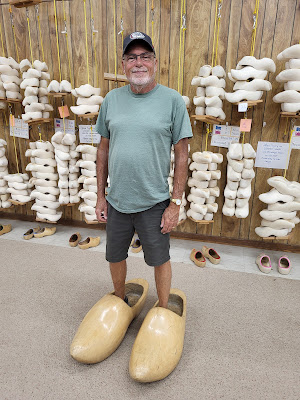We spent nine nights around the Labor Day holiday at East Point RV Resort in Grand Haven. We were parked right on the Grand River, four miles from the mouth that flows into Lake Michigan. Our campsite backed up to the river, so we enjoyed watching the swans, cormorants, herons, and seagulls and during the holiday weekend the boats.
Site #126
GERALD R. FORD PRESIDENTIAL MUSEUM - GRAND RAPIDS, MICHIGAN
Gerald Ford was the 38th president of the United States. His presidential museum is in his hometown of Grand Rapids, Michigan. His Presidential Library is located on the University of Michigan Campus in Ann Arbor, Michigan.
The Museum was very professional and quite interesting. It covers his early life and proceeds through his time as a Boy Scout, star of the high school football team and U of M Wolverines, his service in the Navy during WWII, law practice, U.S. Congressman and finally being appointed Vice President and soon after President.
The auditorium is on the first level. The exhibits are on the second level.
The Oval Office as it appeared during Ford's administration.
Gerald and Betty Ford are interred outside the Museum and along the shore of Grand River.
USS LST 393 - MUSKEGON, MICHIGAN
Of the 1,051 LST (Landing Ship Tank) built for WWII, this one and only one other remains. The ship is now open for self-guided tours during the summer.
The LST 393 earned three battle stars during WWII for the invasion of Sicily, Italy and Omaha Beach on D-Day. She has been fully restored.
These 24-foot bow doors were a unique feature of LSTs. During WWII as LSTs landed on a hostile shore, these doors opened, the ramp came down and tanks and support vehicles roared out.
The tank deck, now used for war memorabilia, held 28 Sherman battle tanks and a huge variety of combat machines and up to 385 troops.
Navigating Bridge Deck
Smaller vehicles and equipment were transported on the top deck and lowered to the main deck via an elevator for unloading.
DE KLOMP WOODEN SHOE & DELFTWARE FACTORY - HOLLAND, MICHIGAN
Holland was founded by Dutch Americans and is in an area that still has a large percentage of citizens of Dutch American heritage. Holland, Michigan, is about ten miles south of Grand Haven. The famous annual Tulip Festival is in Mid-April.
We stopped at the De Klomp Wooden Shoe Factory where the shoes are hand made from blocks of wood. Kurt tried some on. They seemed to run big. Hard to believe that people still wear these.
Delftware is formed here from clay imported from the Netherlands. After the first firing in a kiln, it is hand painted, fired again, then glazed and fired a final time.
There was traditional blue Delftware as well as Poly.
WINDMILL ISLAND GARDENS - HOLLAND, MICHIGAN
The Windmill Island Gardens is a 36-acre park highlighting the history of Holland's Dutch Heritage.
Inside the "Little Netherlands Village" was a miniature Dutch Village diorama. At the end of the row of Dutch houses was a vintage working carousel with hand painted animals.
The tulips were all done for the season, but other flowers put on a showy appearance.
Typical Dutch draw bridge over a canal with a working windmill.
The "De Zwaan" (the Swan) was open for self-guided tours.

The working Dutch windmill from the Netherlands was disassembled into over 7,000 pieces and moved to this site in 1964 under the supervision of a Dutch Millwright.
We climbed the five stories to the top of the mill for an overlook of the gardens.
The Windmill, the centerpiece of the gardens, is 125-feet high with 80-foot moving blades and massive grindstones.
Virginia tried on this wooden shoe, but it was way too big.
This Four Columns player organ was built in 1928 by Carl Frei. The 69-metal key organ was given to the City of Holland in 1947 by the City of Amsterdam in gratitude for the roll of the United State in liberating The Netherlands in WWII. We enjoyed listening to it play twice each hour.
TRI-CITIES HISTORICAL MUSEUM - GRAND HAVEN, MICHIGAN
This museum is small but very well done.
The museum began with displays of the Native Americans, Odawa, Ojibwa, and Potawatomie, who first settled this area.
It proceeded through the fur traders and pioneers. Four rooms of a typical Victorian era home were displayed. After touring the museum, we took the riverfront boardwalk out to Lake Michigan to watch the four foot waves on this windy but sunny summer afternoon.



























No comments:
Post a Comment